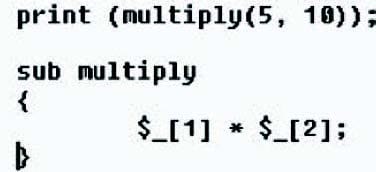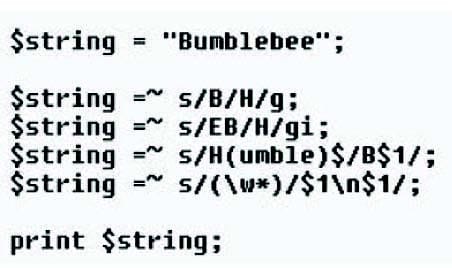Exam Details
Exam Code
:1D0-437Exam Name
:CIW PERL FUNDAMENTALSCertification
:CIW CertificationsVendor
:CIWTotal Questions
:149 Q&AsLast Updated
:Jul 02, 2025
CIW CIW Certifications 1D0-437 Questions & Answers
-
Question 31:
Consider the following lines of code:
sub mySub {
$_ = @_[1];
$a = shift;
$b = shift;
return $a * $b * $_;
}
mySub(1,2,3);
What is the output of these lines of code?
A. No output results from this code.
B. 6
C. 2
D. 4
-
Question 32:
Consider the following program code:
1.$x = 100;
2.$y = 15;
3.$result = $x % $y;
4.
5.print $result;
What is the result of executing this program code?
A. The code will fail at line 3 because % is a unary operator.
B. The code will output the following: 10E+16
C. The code will output the following: 10
D. The code will fail at line 5 because $result is not enclosed by parentheses.
-
Question 33:
Consider the following program code:
@array = ("ALPHA", "beta", "GaMmA");
@array = sort(@array);
print("@array");
What is the output of this code?
A. beta GaMmA ALPHA
B. ALPHA GaMmA beta
C. ALPHA beta GaMmA
D. beta ALPHA GaMmA
-
Question 34:
Which one of the following choices uses the correct syntax for a valid array assignment?
A. @cities = Akron, Memphis, Ogden, Phoenix;
B. @cities =~ ("Akron, Memphis");
C. @cities =~ (Akron, Memphis, Ogden, Phoenix);
D. @cities = ("Akron");
-
Question 35:
Consider the following program code:
@array = ("ALPHA", "beta", "GaMmA");
sort(@array);
print("@array");
What is the output of this code?
A. beta GaMmA ALPHA
B. ALPHA GaMmA beta
C. ALPHA beta GaMmA
D. beta ALPHA GaMmA
-
Question 36:
Consider the following program code:
%employees = ("Lucy", "Accounting", "Armando", "Finance", "Adrienne", "Marketing");
delete($employees{"Lucy"});
Which of the following lines of code has the same effect as the preceding code?
A. %employees = ("Adrienne", "Marketing");
B. %employees = ("Lucy", "Accounting");
C. %employees = ("Lucy", "Accounting", "Armando", "Finance");
D. %employees = ("Armando", "Finance", "Adrienne", "Marketing");
-
Question 37:
Consider the program code in the attached exhibit.

What is the result of executing this program code?
A. The code will output the following: 50
B. The code will output the following: 0
C. The code will output the following: 5
D. The code will output the following: multiply(5, 10)
-
Question 38:
Which of the following choices demonstrates the correct syntax for creating a hash?
A. %passwds = ("denise", "robert", "yolanda") => ("pass1", "pass2", "pass3");
B. %passwds() = ("denise", "pass1", "robert", "pass2", "yolanda", "pass3");
C. %passwds = (denise=> "pass1", robert=> "pass2", yolanda=> "pass3");
D. %passwds{3} = ("denise", "robert", "yolanda") => ("pass1", "pass2", "pass3");
-
Question 39:
Consider the following program code:
$Animal = Dogs bark;
package Cat;
$Animal = Cats purr;
{
package Fish;
$Animal = Fish swim;
}
package main;
print $Animal;
What is the result of executing this program code?
A. The code will fail at line 4.
B. The code will output the following: Dogs bark
C. The code will output the following: Cats purr
D. The code will output the following: Fish swim
-
Question 40:
Consider the program code in the attached exhibit.

What is the result of executing this program code?
A. The code will output the following: Bumblebee
B. The code will output the following: HumhlHee
C. The code will output the following: BumblHee
D. The code will output the following: HumblHee
Related Exams:
1D0-410
CIW Foundations1D0-430
CIW Application Developer1D0-435
CIW JavaScript Fundamentals1D0-437
CIW PERL FUNDAMENTALS1D0-442
CIW EnterprISE SPECIALIST1D0-450
CIW SERVER ADMINISTRATOR1D0-460
CIW INTERNetworking PROFESSIONAL1D0-470
CIW SECURITY PROFESSIONAL1D0-510
CIW v5 Founfations1D0-51B
CIW V5 Foundations SDF Module
Tips on How to Prepare for the Exams
Nowadays, the certification exams become more and more important and required by more and more enterprises when applying for a job. But how to prepare for the exam effectively? How to prepare for the exam in a short time with less efforts? How to get a ideal result and how to find the most reliable resources? Here on Vcedump.com, you will find all the answers. Vcedump.com provide not only CIW exam questions, answers and explanations but also complete assistance on your exam preparation and certification application. If you are confused on your 1D0-437 exam preparations and CIW certification application, do not hesitate to visit our Vcedump.com to find your solutions here.